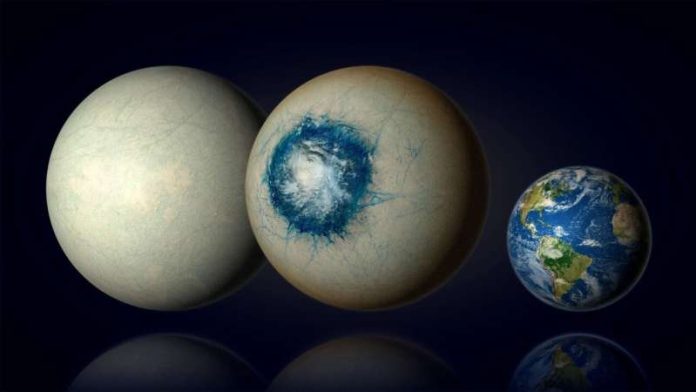
Certain exoplanets pique scientists’ interest more than others. Some of the most interesting are those that lie in the habitable zone of their stars.
However, not all of those planets would be similar to Earth – in fact, finding a planet about the size of Earth is already stretching the limits of most exoplanet-hunting telescopes.
So the scientific community rejoiced when researchers at the Université de Montréal announced they found an exoplanet in the size range of the Earth.
However, it appears to be almost entirely covered in water, making it more similar to a giant version of Europa, the ice-covered moon of Jupiter.
There’s a lot to unpack in the press release describing the discovery. The exoplanet they studied is known as LHS 1140b.
It’s located 48 light-years away in the constellation Cetus, making it one of the closest known exoplanets in its star’s habitable zone.
That star, LHS 1140, is only about 20% the size of our Sun, and the energy it puts out is smaller.
LHS 1140b is one of two potential exoplanets orbiting it, but until now, scientists have debated whether it was a “mini-Neptune” or a “super-Earth.”
If it were a “mini-Neptune,” it would be surrounded by hydrogen gas, but the researchers did not find that.
They used “director’s discretionary time,” which means observational time directly assigned by the project’s director of the James Webb Space Telescope (JWST). They combined it with data collected from TESS, Spitzer, and Hubble.
After looking closely at LHS 1140 b’s atmosphere, they saw something familiar—nitrogen.
This was interesting for a few reasons. First, it ruled out the possibility of LHS 1140b being a “mini-Neptune,” as the hydrogen-rich atmosphere would have been very distinct in the data.
Second, it is now officially the first known temperate exoplanet to have a “secondary” atmosphere – i.e., one created after the planet’s formation.
Nitrogen does not naturally form part of a planet’s atmosphere at the outset and must be developed later through chemical processes. So far, no exoplanets in their star’s habitable zones have been observed with this gas in their atmosphere, though it had long been theorized since our own planet’s atmosphere is so rich in it.
But even more intriguingly, with the possibility that it was a “mini-Neptune” eliminated, it seemed LHS 1140b became a good candidate for a “super-Earth” – about 1.7 times larger than our home planet and 5.6 times its mass.
However, the researchers also noticed the planet was much less dense than expected, indicating that about 10-20% of that mass could be water rather than rock.
Having that much water could lead to several different outcomes. First, there is the possibility of LHS 1140b being a “Hycean world,” which would be entirely covered by a liquid-water ocean. This seems unlikely, as the star’s energy output doesn’t provide enough energy to keep an entire planet-sized ocean warm enough not to freeze.
This leads to the second possibility—a “snowball” world where a thick layer of snow covers the rocky interior. This is still possible, but it requires weather patterns that might be hard to discern remotely, even with JWST.
So that leaves a final possibility—an ice world, where thick sheets of ice cover the entirety of the planet’s surface. We already know of one such world a lot closer to home—Europa. It is completely covered in ice, though intriguingly, it also has a liquid ocean underneath those ice sheets. The researchers think there is a good chance a similar subsurface ocean could exist on LHS 1140b as well.
That would make it the first known exoplanet to have confirmed liquid water. However, the data suggested another intriguing possibility – it could be a snowball planet with a “bull’s eye ocean” at the point where the star’s heat is strongest on it. This ocean could be around 4,000 km across, about half the size of the Atlantic Ocean on Earth. Models suggest that the water temperature in the ocean could even reach 20 C, a comfortable room temperature, though a bit cold to swim in.
However, none of these details have been confirmed yet, and doing so will require—you guessed it—more observational time. In particular, the researchers are interested in whether there is carbon dioxide in LHS 1140b’s atmosphere. A greenhouse gas could make it more likely that the planet’s overall temperature would be warm enough to make it a Hycean world rather than a snowball with one isolated ocean.
Observing carbon dioxide in an exoplanet as far away as LHS 1140 could take years of intermittent observational time on JWST. While LHS 1140b is now definitively one of the most promising candidates for finding liquid water on a planet’s surface – and therefore be a prime candidate for finding life on an exoplanet – continued observation of that kind would have to compete with all the other worthy use cases for JWST’s time.
For now, the researchers hope to receive more observational time, even if it isn’t enough to confirm the presence of carbon dioxide. However, eventually, there will be more and stronger planet-hunting telescopes than even the JWST.
Someday, there will be enough observational time on at least one of them to confirm whether or not LHS 1140b does indeed have a liquid ocean.
That day might be one of the most monumental in the history of the study of exoplanets—and maybe for humanity itself.
Written by Andy Tomaswick.



